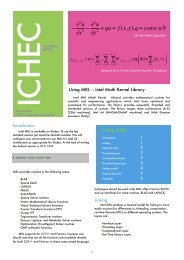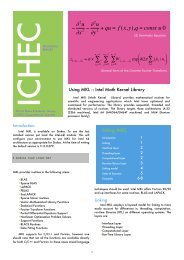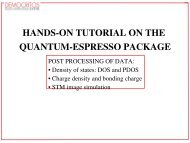Car-Parrinello Molecular Dynamics Simulations With QE
Slides (PDF) - ICHEC
Slides (PDF) - ICHEC
Create successful ePaper yourself
Turn your PDF publications into a flip-book with our unique Google optimized e-Paper software.
AIMD ab-Initio <strong>Molecular</strong> <strong>Dynamics</strong>Born-Oppenheimer MDInitial configuration accumulate statistics Stop Solve the DFTproblem E gs [{R I }] calculate forces F I =∂E gs [{R I }] /∂R Iupdate atomic positions
CPMD <strong>Car</strong>-<strong>Parrinello</strong> <strong>Molecular</strong> <strong>Dynamics</strong>Initial configuration Solve the DFTproblem E gs [{R I }, {ϕ i }] accumulate statistics Stop ionic forces F I = - ∂E tot [{R I }] / ∂R I electronic forces F i = - ∂E tot [{R I }, {ϕ i }] / ∂ϕ i*update atomic positions R Iupdate wave functions ϕ i
Equations of motionElectrons treated as classical scalar fields, followadiabatically the ions remaining close to the ground state.Ions in scaled coordinates, move along the BornOppenheimer surfaceCell shape is driven by the imbalance of internalstress Π and external pressure p.
CP Code main loopFORM NLRHPseudopotential Form factorsRHOOFRρ(r) = Σ |ψ(r)| 2VOFRHO PRESSV(R, ψ) = V r DFT (R, ρ(r)) + VG DFT (R, ρ(G))FORCEForces on the electrons: F ψORTHOOrthogonalize wave functions: ψ
Key CP parametersdt time step(dt -> common values 2-10 in Hartree atomic units1 a.u.=4.8378 * 10^-17 s : beware, PW code useRydberg atomic units, twice that much!!!)µ effective electronic mass(emass -> common values 100-1000 a.u. of mass1 a.u. = 1/1822.9 a.m.u. = 9.10939 * 10^-31 kg )
Key CP parameters(for NVT)T temperature(tempw -> 300-1000 in Kelvin )Q Nose-Hoover thermostat mass(for the input use the frequencyfnosep -> 10-100 in terahertz )
Key CP parameters(for NPT)W effective cell mass(wmass ~3ΣM i /4π 2 a.u. of mass )P external (hydrostatic) pressure(press -> 0 – 1000 Kbar )
Parameters setupYou want to simulate your systemwith given tempw, pressRemaining on the BO surface!Tune: dt, emass, wmassSome test run may be required!
Parameters relationsgap emass dtcut-offwmasstempwdtdtdt
CP in <strong>QE</strong>CPV subdirectoryExecutable: cp.xNO K-points, only GAMMA, no PAWExample: 18, 19, 20, 21, 23, 26, 27,30, autopilot-example,Restart_example, <strong>QE</strong>xml_exampleTests: cptests
A CP simulation require usually many RUNs and JOBs1. Minimize the Electronic degrees of freedom( d.o.f. )2. Minimize the ionic d.o.f.3. Randomize ionic d.o.f.4. Re-minimize Electronic d.o.f5. Move Electronic and Ionic d.o.f. using Verlet tointegrate the equations of motion6. Change temperature using thermostat7. Accumulate statistics for few picoseconds ofsimulated time ( 20000 – 40000 time steps )
Electronic Minimization I/IICP time step (in a.u.)convergence threshold,effective only for minimization&CONTROLtitle = ' Water Molecule ',calculation = 'cp',restart_mode = 'from_scratch',prefix = 'h2o_mol‘nstep = 50,dt = 5.0d0,etot_conv_thr = 1.d-9,ekin_conv_thr = 1.d-4,/number of CP stepEnergy cut-off,in Rydberg&SYSTEMibrav = 1,celldm(1) = 10.0,nat = 3, ntyp = 2,ecutwfc = 70.0,/Simulation Cell (in a.u.)number of atom,and species
Electronic Minimization II/IIFictitious electron mass (a.u.)µ parameter in CP dynamicPW Energy cut-off (in Rydberg)for Fourier Acceleration&ELECTRONSemass = 400.d0,emass_cutoff = 2.5d0,orthogonalization = 'ortho',electron_dynamics = 'sd',/&IONSion_dynamics = 'none',/orthogonalizationalgorithm‘ortho’ or 'Gram-Schmidt'electron dynamicssd -> steepest descenddamp -> dampedverlet -> VerletLabel Mass (uma) PPLabel x y zATOMIC_SPECIESO 16.0d0 O.BLYP.UPFH 1.00d0 H.fpmd.UPFATOMIC_POSITIONS (bohr)O 0.0099 0.0099 0.0000H 1.8325 -0.2243 -0.0001H -0.2243 1.8325 0.0002ion dynamicsnone -> kept fixedsd -> steepest descenddamp -> dampedverlet -> Verlet
CP – <strong>Dynamics</strong> I/II&CONTROLtitle = ' Water Molecule ',calculation = 'cp',restart_mode = ‘restart',nstep = 50,dt = 5.0d0,prefix = 'h2o_mol'/&SYSTEMibrav = 1,celldm(1) = 10.0,nat = 3, ntyp = 2,ecutwfc = 70.0,/&ELECTRONSemass = 400.d0,emass_cutoff = 2.5d0,orthogonalization = 'ortho',electron_dynamics = ‘verlet',electron_velocities = ‘zero’/verlet should be usedfor ions and electrons&IONSion_dynamics = ‘verlet',ion_velocities = ‘zero’/ATOMIC_SPECIESO 16.0d0 O.BLYP.UPF 4H 1.00d0 H.fpmd.UPF 4ATOMIC_POSITIONS (bohr)O 0.0099 0.0099 0.0000H 1.8325 -0.2243 -0.0001H -0.2243 1.8325 0.0002in the very first run ofdynamics velocitiesshould be set to zero
CP – <strong>Dynamics</strong> II/II ( thermostat )&CONTROLtitle = ' Water Molecule ',calculation = 'cp',restart_mode = ‘restart',nstep = 50,dt = 5.0d0,prefix = 'h2o_mol'/&SYSTEMibrav = 1,celldm(1) = 10.0,nat = 3, ntyp = 2,ecutwfc = 70.0,/&ELECTRONSemass = 400.d0,emass_cutoff = 2.5d0,orthogonalization = 'ortho',electron_dynamics = ‘verlet',/Termostat temperature and frequencytempw ( Kelvin )fnosep ( THz )&IONSion_dynamics = ‘verlet',ion_temperature = ‘nose’tempw = 300,fnosep = 70.0/ATOMIC_SPECIESO 16.0d0 O.BLYP.UPF 4H 1.00d0 H.fpmd.UPF 4ATOMIC_POSITIONS (bohr)O 0.0099 0.0099 0.0000H 1.8325 -0.2243 -0.0001H -0.2243 1.8325 0.0002








